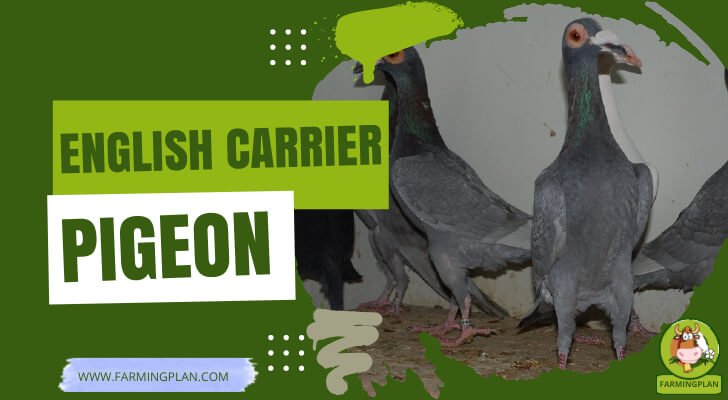When I first heard about the English Carrier Pigeon, I never imagined how captivating these birds could be. I was intrigued by their incredible homing abilities and how they once played a crucial role in communication. As I began learning more, I decided to raise my pigeons. The journey has been nothing short of amazing. Watching them take flight and return to their loft with such precision fills me with awe. These pigeons are not just birds; they are living pieces of history, reminding us of the power of instincts and communication.

What is an English Carrier Pigeon?
- An English Carrier Pigeon is a specific breed of homing pigeon known for its exceptional ability to navigate and return to its home loft. This breed primarily carried messages before modern communication methods were invented. With a strong instinct to return to their home, these pigeons played an essential role during times of war and in other areas where communication was critical.
- Though they are not as commonly used today, their role in history has made them one of the world’s most famous and revered pigeon breeds. They are considered highly reliable, with an uncanny ability to find their way across vast distances. Their communication ability made them invaluable during World Wars I and II when they were used to deliver vital information in times of need.
Read More: Lahore Pigeon
The History of English Carrier Pigeons
- The English Carrier Pigeon has a fascinating history that dates back to ancient times. The Greeks and Romans first used carrier pigeons to deliver messages over long distances. However, the breed we now know as the English Carrier Pigeon was developed in England in the 19th century.
- Pigeons were selectively bred for their homing ability, strength, and reliability. As communication became more complex, especially during wartime, military forces used pigeons to send messages when other methods, like wires or radio signals, were unavailable or unreliable.
- Carrier pigeons were vital during World War I and World War II. The most famous carrier pigeon of World War II was Cher Ami, who, despite being injured, saved the lives of several soldiers by delivering a message.
Key Characteristics of the English Carrier Pigeon
The English Carrier Pigeon has a few distinct physical characteristics that make it ideal for message delivery. Some of these features include:
- Size: They are medium to large, making them strong enough to carry small messages.
- Feather Color: Their feathers can be of various colors, but the most common color is grayish blue with iridescent hues on the neck and wings.
- Shape and Build: English carrier pigeons are robust, muscular, and designed forces. Their wings are broad and capable of flying at high speeds.
- Homing Instinct: One of the most essential features of the English Carrier Pigeon is its homing instinct. This is the English carrier pigeon’s-pigeon’s pigeon’s most crucial feature from miles away, which is the instinct key to its message-carrying ability.
Read More: Indian Fantail Pigeon
How Do English Carrier Pigeons Communicate?
Carrier pigeons, including the English Carrier Pigeon, are fantastic at navigating long distances. This is due to their homing instinct, an innate skill that allows them to return to their loft continually.
- Message Delivery: A small message is typically attached to the bird’s leg using a small capsule or container to communicate with a pigeon. Once released, the pigeon returns to its home loft, where the message can be retrieved.
- Navigation Process: The exact mechanism of pigeons’pigeons’pigeons’ navigation remains somewhat of a mystery, but pigeons are believed to use a combination of the earth’searth’searth’s magnetic field, the position of the sun, and landmarks to find their way home.
- Reliability: English Carrier Pigeons are incredibly reliable. They can fly up to 600 miles daily, perfect for delivering time-sensitive messages across vast distances.
Breeding Techniques for English Carrier Pigeons
Breeding English Carrier Pigeons requires careful selection of the birds with the best traits. To ensure that pigeons can successfully carry messages, breeders focus on several factors:
- Strength: The pigeons must be strong enough to fly long distances.
- Homogeneity: Breeders aim for consistency in homing ability, meaning the birds should always return to the same loft reliably.
- Health: Healthy pigeons are more likely to be efficient at long-distance flights. Proper care and attention to diet are crucial.
- Lineage: Breeders often select pigeons with the best-proven breeding records to maintain the breed high standards.
Training English Carrier Pigeons
Training a pigeon to deliver messages involves several steps, including getting the pigeon familiar with its loft, teaching it the return flight, and ensuring it recognizes the home location. Here’sHere’sHere’s how you can train your English Carrier Pigeon:
- Introduce the Loft: The first step is to make the pigeon comfortable with its loft. The loft should be a safe, familiar environment where the pigeon feels secure.
- Short Flights: Once the pigeon is accustomed to its loft, let it fly short distances and gradually increase the distance as the pigeon becomes more confident.
- Repetition: Repeat this process over several weeks. The pigeon will begin to learn that the loft is its home, and it will return there automatically.
- Message Attachment: Once the pigeon is trained to return home, you can attach small messages to its leg. Start with short flights and gradually extend the distance.
- Practice: The more you practice, the better the pigeon will become at its task. It’s essential to be patient and consistent.
Read More: Jacobin Pigeon
Caring for Your English Carrier Pigeon Loft
Caring for their loft ensures your English Carrier Pigeons are happy and healthy. Here are a few tips for maintaining a good loft environment:
- Cleanliness: The loft should be kept clean and dry. Regularly cleaning the floor, perches, and other surfaces will help prevent disease.
- Ventilation: Proper ventilation is essential for the pigeons health. Ensure adequate airflow, but avoid drafts that could harm the birds.
- Feeding: Pigeons need a balanced diet to stay healthy. Provide a mixture of seeds, grains, and occasional supplements to keep them strong.
- Health Checks: Regular health checks are necessary to prevent diseases and infections. Make sure your pigeons have access to fresh water at all times.
Why Carrier Pigeons Are No Longer Used in Modern Communication
- The need for carrier pigeons has diminished with the rise of telephones, radios, and the InternetInternetInternetInternet. While pigeons were once the most reliable method of communication over long distances, modern technology has made them obsolete.
- However, carrier pigeons are still admired for their incredible abilities and play an essential role in pigeon racing and as pets. There are also efforts to preserve the history of pigeons, with museums and historical sites dedicated to their role in wartime communication.
Fun Facts About English Carrier Pigeons
- Survival Skills: Despite being bred for message delivery, pigeons are excellent at survival. They can fly in various weather conditions and have been known to return to their lofts even after long journeys.
- Military Heroes: During World War II, carrier pigeons saved thousands of lives by delivering vital messages. One famous pigeon, Cher Ami, was awarded the French Croix de Guerre for bravery.
- Pigeon Racing: Today, carrier pigeons are primarily used for racing. The pigeons are released from a remote location and must return to their home loft as fast as possible. These races are highly competitive and enjoyed by many pigeon enthusiasts.
Tips for Beginners in Raising English Carrier Pigeons
If you’re interested in raising English Carrier Pigeons, here are some tips to get you started:
- Choose Healthy Birds: Select healthy, well-bred pigeons from reputable breeders.
- Build a Comfortable Loft: A good loft will provide your pigeons a safe space to rest, eat, and breed.
- Be Patient: Training pigeons takes time. Be consistent with your training and give them time to adapt to their new home.
- Join a Community: Connect with other pigeon enthusiasts to learn more and exchange tips and advice.
Read More: Pouter Pigeon
FAQs
What is an English Carrier Pigeon?
An English Carrier Pigeon is a breed of homing pigeon used historically to deliver messages due to its strong navigation abilities.
How far can English Carrier Pigeons fly?
English Carrier Pigeons can fly up to 600 miles daily, thanks to their exceptional homing instincts.
Why are English Carrier Pigeons no longer used for communication?
They are no longer needed due to modern communication technologies like phones, radio, and the Internet.
How are English Carrier Pigeons trained?
They are trained by gradually increasing flight distances and familiarizing them with their loft as their home.
Are English Carrier Pigeons still bred today?
They are still bred for racing, as pets, and to preserve their historical significance.
Conclusion
The English Carrier Pigeon, known for its remarkable ability to deliver messages over long distances, has played a crucial role in communication history, particularly during wartime. These pigeons are bred for their homing ability and reliability, and they can be trained to fly back to their lofts with messages. Although modern technology has replaced their use in communication, their legacy continues through pigeon racing and as beloved pets. Understanding their history, characteristics, and care will deepen appreciation for these extraordinary birds and their essential role in human communication.


